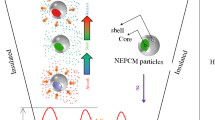Abstract
The utilization of nanofluids has found numerous applications in various industries, including transportation, electronics, and energy. By substituting conventional fluids with nanofluids, heat transfer rates can increase. This not only enhances engine efficiency, leading to decreased fuel consumption but also enables the design of more powerful engines adaptable to various climates. This study focuses on a hybrid nanofluid composed of graphene oxide and silicon oxide nanoparticles in a water-ethylene glycol base fluid, which can have an application in car radiators. Experiments, validated with distilled water, explored various volume fractions (0.1 % to 1.0 %) and coolant flow rates (3 to 7 l/min). Results showed that increasing flow rates improved heat transfer, displacement heat transfer coefficient (HTC), and Nusselt number. Similarly, higher nanoparticle fractions enhanced heat transfer and HTC with minimal pressure drop. The radiator's thermal performance significantly improved with nanofluid use, but a reduction in HTC relative to pumping power was noted.















Similar content being viewed by others
Availability of Data and Material
The data and material are available and can be presented in the case of needed.
References
S.U.S. Choi, W. Yu, J.R. Hull, Z.G. Zhang, F.E. Lockwood, S.A.E. Int, J. Passeng. Cars Mech. Syst. 111, 38–43 (2002)
S.C. Tzeng, C.W. Lin, K.D. Huang, Acta Mech. 179, 11–23 (2005)
K.R. Aglawe, R.K. Yadav, S.B. Thool, Mater. Today: Proc. 43, 366–372 (2021)
J. Sarkar, Renew. Sust. Energ. Rev. 15, 3271–3277 (2011)
V. Sridhara, B.S. Gowrishankar, Snehalatha, L.N. Satapathy, Trans. Indian Ceram. Soc. 68, 1–17 (2009)
K.J. Park, D. Jung, Energy Build. 39, 1061–1064 (2007)
G. Yıldız, Ü. Ağbulut, A.E. Gürel, Int. J. Refrig. 129, 342–364 (2021)
V. Trisaksri, S. Wongwises, Int. J. Heat Mass Transf. 52, 1582–1588 (2009)
G. Ding, H. Peng, W. Jiang, Y. Gao, Int. J. Refrig. 32, 114–123 (2009)
A. Bhattad, J. Sarkar, P. Ghosh, Renew. Sust. Energ. Rev. 82, 3656–3669 (2018)
R. Saidur, S.N. Kazi, M.S. Hossain, M.M. Rahman, H.A. Mohammed, Renew. Sust. Energ. Rev. 15, 310–323 (2011)
K. Emmenthal, W. Hucho, SAE Technical Paper 740088 (1974) https://doi.org/10.4271/740088
J.P. Chiou, SAE Int. 89, 222–230 (1980)
M. Gollin, D. Bjork, SAE Technical Paper 960372 (1996) https://doi.org/10.4271/960372
S.C. Morris, J.J. Good, J.F. Foss, Exp. Therm. Fluid Sci. 17, 100–106 (1998)
J.J. JuGer, R.F. Crook, S.A.E. Int, J. Engines 108, 71–81 (1999)
J.A. Chen, D.F. Wang, L.Z. Zheng, Proc. Inst. Mech. Eng. D 215, 911–918 (2001)
E. Carluccio, G. Starace, A. Ficarella, D. Laforgia, Appl. Therm. Eng. 25, 1995–2013 (2005)
A. Witry, M.H. Al-Hajeri, A.A. Bondok, Appl. Therm. Eng. 25, 1207–1218 (2005)
J.L. Routbort, D. Singh, G. Chen, Heavy vehicle systems optimization merit review and peer evaluation. (Argonne National Laboratory USA, 2007), https://www.energy.gov/eere/analysis/articles/heavy-vehicle-systems-optimization-peer-review
E. Çiftçi, Int. J. Thermophys. 42, 38 (2021)
K. Martin, A. Sözen, E. Çiftçi, H.M. Ali, Int. J. Thermophys. 41, 1–21 (2020)
A. Karimipour, O. Malekahmadi, A. Karimipour, M. Shahgholi, Z. Li, Int. J. Thermophys. 41, 116 (2020)
A. Vărdaru, G. Huminic, A. Huminic, C. Fleacă, F. Dumitrache, I. Morjan, Alex. Eng. J. 61, 12111–12122 (2022)
A.A. Mahyari, A. Karimipour, M. Afrand, Physica A 521, 98–112 (2019)
F.M. White, Fluid Mechanics, 7th edn. (Mcgraw-Hill series in mechanical engineering, 2011)
K.D. Hagen, Heat Transfer with Applications, 1st edn. (Prentice Hall, Hoboken, 1998)
A. Bejan, Convection Heat Transfer, 4th edn. (Wiley, New York, 2013)
H.W. Coleman, W.G. Steele, Experimentation, Validation, and Uncertainty Analysis for Engineers, 3rd edn. (Wiley, New York, 2018)
S.S. Murshed, K.C. Leong, C. Yang, N.T. Nguyen, Int. J. Nanosci. 7, 325–331 (2008)
T.L. Bergman, A.S. Lavine, F.P., Incropera, D.P. DeWitt, Introduction to Heat Transfer, 6th edn. (Wiley, New York, 2011)
F.W. Dittus, Univ. Cal. Pub. Eng. 2, 443–461 (1930)
Author information
Authors and Affiliations
Contributions
All authors wrote the main manuscript text and they all prepared the figures; and all authors reviewed the manuscript.
Corresponding author
Ethics declarations
Conflict of interest
There is no conflict of interest.
Additional information
Publisher's Note
Springer Nature remains neutral with regard to jurisdictional claims in published maps and institutional affiliations.
Rights and permissions
Springer Nature or its licensor (e.g. a society or other partner) holds exclusive rights to this article under a publishing agreement with the author(s) or other rightsholder(s); author self-archiving of the accepted manuscript version of this article is solely governed by the terms of such publishing agreement and applicable law.
About this article
Cite this article
Rashidi, O., Sajadi, S.M., Soufivand, M. et al. Experimental Study to Improve the Hydrodynamic and Thermal Efficiencies of a Cross-Flow Car Radiator Using a New Prepared Hybrid Nanofluid Composed of Graphene Oxide and Silicon Oxide Nanoparticles Dispersed in Water–Ethylene Glycol Fluid. Int J Thermophys 45, 23 (2024). https://doi.org/10.1007/s10765-023-03310-2
Received:
Accepted:
Published:
DOI: https://doi.org/10.1007/s10765-023-03310-2




